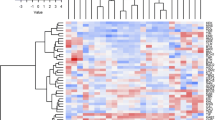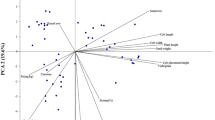Abstract
The maize landraces in the North East Himalayan (NEH) region in India, especially in the Sikkim state, are morphologically highly diverse. The present study provides details of phenotypic and molecular characterization of a set of 48 selected maize landrace accessions, including the ‘Sikkim Primitives’ which have a unique habit of prolificacy (5–9 ears on a single stalk). Multi-location phenotypic evaluation of these 48 accessions revealed significant genetic variability for grain yield and its components, leading to identification of several promising accessions. Cluster analysis and PCA using nine morpho-agronomic characters clearly separated ‘Sikkim Primitives’ from the rest of the accessions. PCA revealed two principal components describing 90% of the total variation, with hundred kernel weight, ear length, ear diameter, number of kernels per ear and flowering behaviour forming the most discriminatory traits. The accessions were genotyped using 42 microsatellite or simple sequence repeat (SSR) markers using a ‘population bulk DNA fingerprinting strategy’, with allele resolution using an automated DNA Sequencer. The study revealed a high mean number of alleles per SSR locus (13.0) and high Polymorphism Information Content (PIC) value of 0.60. The analysis also led to identification of 163 private/unique alleles, differentiating 44 out of 48 accessions. Six highly frequent SSR alleles were detected at different loci (phi014, phi062, phi090, umc1266, umc1367 and umc2250) with individual frequencies ≥0.75. Some of these SSR loci were reported to tag specific genes/QTL for some important traits, indicating that chromosomal regions harboring these SSR alleles were not selectively neutral. Cluster analysis using Rogers’ genetic distance also revealed distinct genetic identity of the ‘Sikkim Primitives’ from the rest of the accessions in India, including Sikkim. Mantel’s test revealed significant and positive correlation between the phenotypic and molecular genetic dissimilarity matrices. The study was the first to portray the patterns of phenotypic and molecular diversity in the maize landraces from the NEH region in India.



Similar content being viewed by others
References
Azar C, Mather DE, Hamilton RI (1997) Maize landraces of the St. Lawrence–Great Lakes region of North America. Euphytica 98:141–148
Berg EE, Hamrick JL (1997) Quantification of genetic diversity at allozyme loci. Can J Forest Res 27:415–424
Beyene Y, Botha A, Alexander AM (2005) A comparative study of molecular and morphological methods of describing genetic relationships in traditional Ethiopian highland maize. African J Biotechnol 4:586–595
Beyene Y, Botha A, Alexander AM (2006) Genetic diversity among traditional Ethiopian highland maize accessions assessed by simple sequence repeat (SSR) markers. Genet Resour Crop Evol 53:1579–1588
Bonnet E, Van de Peer Y (2002) zt: a software tool for simple and partial Mantel tests. J Stat softw 7:1–12
Chopra S, Cocciolone SM, Bushman S, Sangar V, McMullen MD, Peterson T (2003) The maize unstable factor for orange1 is a dominant epigenetic modifier of a tissue specifically silent allele of pericarp color1. Genetics 163:1135–1146
Daniels J, Holmans P, Williams N, Turic D, McGuffin P, Plomin R, Owen MJ (1998) A simple method for analyzing microsatellite allele image patterns generated from DNA pools and its application to allelic association studies. Am J Hum Genet 62:1189–1197
Dhawan NL (1964) Primitive maize in Sikkim. Maize Genet Coop Newslett 38:69–70
Dubreuil P, Rebourg C, Merlino M, Charcosset A (1999) The DNA-pooled sampling strategy for estimating the RFLP diversity of maize populations. Plant Mol Biol Rep 17:123–138
Dubreuil P, Warburton ML, Chastanet M, Hoisington D, Charcosset A (2006) More on the introduction of temperate maize into Europe: large-scale bulk SSR genotyping and new historical elements. Maydica 51:281–291
Franco J, Crossa J, Ribaut JM, Betran J, Warburton ML, Khairallah M (2001) A method for combining molecular markers and phenotypic attributes for classifying plant genotypes. Theor Appl Genet 103:944–952
Franco J, Warburton M, Dubreuil P, Dreisigacker S (2005) User’s manual for the FREQS-R program for estimating allele frequencies for fingerprinting and genetic diversity studies using bulked heterogeneous populations. CIMMYT, Mexico
Franco J, Warburton M, Dreisigacker S (2007) User’s manual for the FtoL-R program. CIMMYT, Mexico DF
Garris AJ, Thomas HT, Coburn J, Kresovich S, McCouch S (2005) Genetic structure and diversity in Oryza sativa L. Genetics 169:1631–1638
Gouesnard B, Dallard J, Panouille A, Boyat A (1997) Classification of French maize populations based on morphological traits. Agronomie 17:491–498
Grant UJ, Wellhausen EJ (1955) A study of corn breeding and production in India. Ministry of Food and Agriculture, Govt. of India, New Delhi
Hamblin MT, Warburton ML, Buckler ES (2007) Empirical comparison of simple sequence repeats and single nucleotide polymorphisms in assessment of maize diversity and relatedness. PLoS One 12:e1367
Hartings H, Berardo N, Mazzinelli GF, Valoti P, Verderio A, Motto M (2008) Assessment of genetic diversity and relationships among maize (Zea mays L.) Italian landraces by morphological traits and AFLP profiling. Theor Appl Genet 117:831–842
Hintze J (2000) Number cruncher statistical systems (NCSS). Kaysville, UT
LeDuc C, Miller P, Lichter J, Parry P (1995) Batched analysis of genotypes. PCR Methods Appl 4:331–336
Liu K, Muse SV (2005) PowerMarker: integrated analysis environment for genetic marker data. Bioinformatics 21:2128–2129
Liu K, Goodman M, Muse SV, Smith JS, Buckler ES, Doebley J (2003) Genetic structure and diversity among maize inbred lines as inferred from DNA microsatellites. Genetics 165:2117–2128
Mantel N (1967) The detection of disease clustering and a generalized regression approach. Cancer Res 27:209–220
Matsuoka Y, Mitchell SE, Kresovich S, Goodman M, Doebley J (2002) Microsatellites in Zea—variability, patterns of mutations, and use for evolutionary studies. Theor Appl Genet 104:436–450
Moeller DA, Tenaillon MI, Tiffin P (2007) Population structure and its effects on patterns of nucleotide polymorphism in Teosinte (Zea mays ssp. parviglumis). Genetics 176:1799–1809
Perlin MW, Lancia G, Ng SK (1995) Towards fully automated genotyping: genotyping microsatellite markers by deconvolution. Am J Hum Genet 57:1199–1210
Perrier X, Flori A, Bonnot F (2003) Data analysis methods. In: Hamon P, Seguin M, Perrier X, Glaszmann JC (eds) Genetic diversity of cultivated tropical plants. Enfield Science Publishers, Montpellier, pp 43–76
Prasanna BM, Hoisington D (2003) Molecular breeding for maize improvement: an overview. Indian J Biotechnol 2:85–98
Prasanna BM, Sharma L (2005) The landraces of maize (Zea mays L.): diversity and utility. Indian J Plant Genet Resour 18:155–168
Prasanna BM, Singode A, Garg A, Kumar R, Singh BB (2007) Molecular characterization of maize genetic resources in India: present status and prospects. In: Pixley K, Zhang SH (eds) Proceedings of the ninth Asian regional maize workshop. Beijing, China, pp 40–43
Pressoir G, Berthaud J (2004) Patterns of population structure in maize landraces from the Central Valleys of Oaxaca in Mexico. Heredity 92:88–94
Qi-Lun Y, Ping F, Ke-Cheng K, Guang-Tang P (2008) Genetic diversity based on SSR markers in maize (Zea mays L.) landraces from Wuling mountain region in China. J Genet 87:287–291
R Development Core Team (2005) R: a language and environment for statistical computing, reference index version 2.2.1. R Foundation for Statistical Computing, Vienna, Austria (http://www.R-project.org)
Rebourg C, Dubreuil P, Charcosset A (1999) Genetic diversity among maize populations: bulk RFLP analysis of 65 accessions. Maydica 44:237–249
Rebourg C, Gouesnard B, Charcosset A (2001) Large scale molecular analysis of traditional European maize populations—relationships with morphological variation. Heredity 86:574–587
Rebourg C, Chastanet M, Gouesnard B, Welcker C, Dubreuil P, Charcosset A (2003) Maize introduction into Europe: the history reviewed in the light of molecular data. Theor Appl Genet 106:895–903
Reif JC, Melchinger AE, Frisch M (2005) Genetical and mathematical properties of similarity and dissimilarity coefficients applied in plant breeding and seed bank management. Crop Sci 45:1–7
Rogers JS (1972) Measures of similarities and genetics distances. In: Wheeler MR (ed) Studies in genetics VII. Univ Texas Publ, Texas, pp 145–153
Ruiz de Galarreta JI, Alvarez A (2001) Morphological classification of maize landraces from northern Spain. Genet Resour Crop Evol 48:391–400
Sachan JKS, Sarkar KR (1982) Plant type of ‘Sikkim Primitives’. Maize Genet Coop Newslett 56:122–124
Sachan JKS, Sarkar KR (1986) Discovery of Sikkim Primitive precursor in the Americas. Maize Genet Coop Newslett 60:104–106
SAS Institute (2005) Statistical analysis system (SAS) software, version 9.1. SAS Institute, Cary
Singh B (1977) Races of maize in India. Indian Council of Agricultural Research, New Delhi
Smith JSC, Smith OS (1992) Fingerprinting crop varieties. Adv Agron 47:85–140
Stonor CR, Anderson E (1949) Maize among the hill peoples of Assam. Ann Mo Bot Gard 36:355–404
Suto T, Yoshida Y (1956) Characteristics of the oriental maize. In: Kihara H (ed) Land and crops of Nepal Himalaya, vol 2. Fauna and Flora Research Society University Kyoto, Japan, pp 375–530
Warburton ML, Xianchun X, Crossa J, Franco J, Melchinger AE, Frisch M, Bohn M, Hoisington D (2002) Genetic characterization of CIMMYT inbred maize lines and open pollinated populations using large scale fingerprinting methods. Crop Sci 42:1832–1840
Acknowledgments
The study was undertaken as a part of the Indian Council of Agricultural Research (ICAR) National Fellow Project awarded to BMP. The authors thank the Division of Germplasm Conservation, National Bureau of Plant Genetic Resources (NBPGR), New Delhi (especially Dr. Kalyani Srinivasan) for providing seed material of some of the landrace accessions used in this study.
Author information
Authors and Affiliations
Corresponding author
Rights and permissions
About this article
Cite this article
Sharma, L., Prasanna, B.M. & Ramesh, B. Analysis of phenotypic and microsatellite-based diversity of maize landraces in India, especially from the North East Himalayan region. Genetica 138, 619–631 (2010). https://doi.org/10.1007/s10709-010-9436-1
Received:
Accepted:
Published:
Issue Date:
DOI: https://doi.org/10.1007/s10709-010-9436-1




